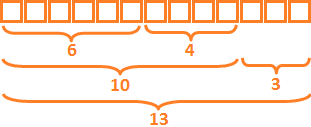1. Addition and Subtraction, Concept of complement to 10
The 10's complement method is used to find sums greater than 10.
We will first define the concept of complement to 10. Then, we will give some examples in order to understand the method.
Concept of complement to 10
The complement to 10 of a number is what you add to that number to get 10. Learn the following operations by heart:
9+1=10 1 is the complement to 10 of 9 and 9 is the complement to 10 of 1.
8+2=10 2 is the complement to 10 of 8 and 8 is the complement to 10 of 2.
7+3=10 3 is the complement to 10 of 7 and 7 is the complement to 10 of 3.
6+4=10 4 is the complement to 10 of 6 and 6 is the complement to 10 of 4.
5+5=10 5 is the complement to 10 of 5.
Complement to 10 method for addition
To get the sum of two numbers, which I call number1 and number2, I subtract the complement to 10 of number1 from number2 and then add it to 10.
Let's take the example 7 + 5 :

To make the calculation easier, I split 5 into 3 + 2. I chose 3 because it is the complement to 10 of 7. I find 2 by calculating 5 - 3.

I bring back 3 with 7 which gives 10. All I have to do is add 2 to 10, which is the easiest thing to do because you only have to put 2 in units and 1 in tens.

Case of the number 9
The complement to 10 of the number 9 is 1. So, to add a number to 9, I subtract 1 from that number and add 10.
For example, 9+5:
I do 5-1=4 and add 10; result: 9+5=14
Case of the number 8
The complement to 10 of the number 8 is 2. So, to add a number to 8, I subtract 2 from that number and add 10.
For example, 8+7:
I do 7-2=5 and add 10; result: 8+7=15
Case of the number 7
The complement to 10 of the number 7 is 3. So, to add a number to 7, I subtract 3 from that number and add 10.
For example, 7+4:
I do 4-3=1 and add 10; result: 7+4=11
Case of the number 6
The complement to 10 of the number 6 is 4. So, to add a number to 6, I subtract 4 from that number and add 10.
For example, 6+9:
I do 9-4=5 and add 10; result: 6+9=15
Complement to 10 method for subtractions
The subtraction of a digit I call digit2 from a digit assumed to be greater than 10, which I call digit1, is the sum of the complement to 10 of digit2 and the units digit of digit1.
Let's take the example 13 - 6 :
The difference between 13 and 6 is what you have to add to 6 to get 13.
![]()
First I add 4 to get 10. 4 is the complement to 10 of 6.

The difference between 10 and 13 is very easy, it is 3.

So the difference between 6 and 13 is 4+3=7.
Case of the number 9
The complement to 10 of the number 9 is 1. So, to subtract 9 from a number (between 11 and 18), I add 1 to the units digit of that number.
For example, 17-9 :
I do 7+1=8; so 17-9=8
Case of the number 8
The complement to 10 of the number 8 is 2. So, to subtract 8 from a number (between 11 and 17), I add 2 to the units digit of that number.
For example, 15-8 :
I do 5+2=7; so 15-8=7
Case of the number 7
The complement to 10 of the number 7 is 3. So, to subtract 7 from a number (between 11 and 16), I add 3 to the units digit of that number.
For example, 16-7 :
I do 6+3=9; so 16-7=9
Case of the number 6
The complement to 10 of the number 6 is 4. So, to subtract 6 from a number (between 11 and 15), I add 4 to the units digit of that number.
For example, 14-6 :
I do 4+4=8; so 14-6=8
Using 100 as a reference
With the so-called complement to 10 method. The value 10 is taken as a reference. The reason is of course that calculations with this value are easy.
To solve certain operations, it is appropriate to work with another reference. The reference 100 is suitable for the following operation:
96 + 45
To reach 100, I have to add 4 to 96. To avoid counting the 4 twice, I have to subtract it from 45. This gives 41. By adding 100, I get the result 141.
Another example :
Consider the operation 123 - 94. This is the number to add to 94 to reach 123.
The result is 6+23=29. This is because from 94 I have to add 6 to get 100 and from 100 I have to add 23 to get 123.
Complement to 100 of a number
It is important to remember that to get the complement to 100 of a number, the complement to 10 must be put in units and the complement to 9 in tens.
For example, the complement to 100 of 36 ?
In units it is 4 and in tens it is 6 (9-3=6).
Result: 100-36=64
Use of other values as references
Consider the operation 48+36.
I will add 2 to 48 to get 50. I must therefore subtract the 2 from 36:
48+36=50+34=84
Consider the operation 85-37.
From 37, I add 3, I get 40. From 40, I have to add 45 to get 85. The operation is equivalent to 3+45:
85-37=3+45=48.
Use the link Addition Tables to review the addition tables.
Use the link Addition Operations to practise addition operations.